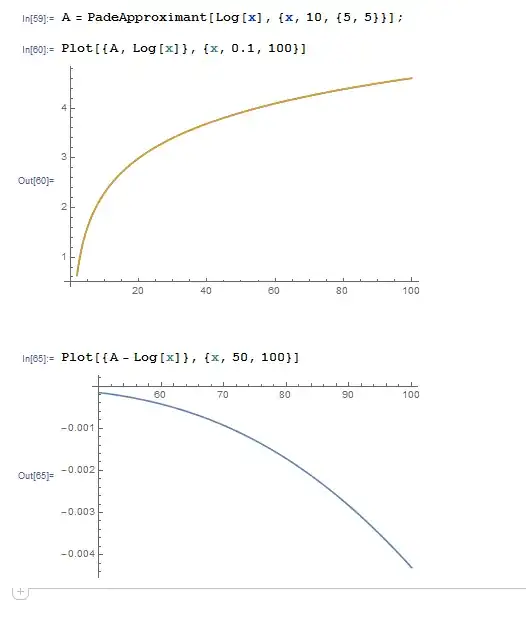I'm trying to find the result of $\log{x}$ (base 10) close to exact value in two digits with these methods:
The methods below are doing by hand. I appreciate you all who already give answers for computer method.
As suggested by Praktik Deoghare's answer
If number N (base 10) is n-digit then $$n-1 \leq \log_{10}(N) < n$$ Then logarithm can be approximated using $$\log_{10}(N) \approx n-1 + \frac{N}{10^{n} - 10^{n-1}}$$ Logarithm maps numbers from 10 to 100 in the range 1 to 2 so log of numbers near 50 is about 1.5. But this is only a linear approximation, good for mental calculation and toy projects but not that good for serious research.
This method is cool for me, but it's nearly close to exact value. $\log_{10}(53)$ is 1.7 and with that method results 1.58.
As suggested by Pedro Tamaroff's answer
One can get very good approximations by using $$\frac 1 2 \log \left|\frac{1+x}{1-x}\right| =x+\frac {x^3} 3+ \frac {x^5}5+\cdots$$ Say you want to get $\log{3}$. Then take $x=1/2$. Then you get $$\log 3 \approx 2\left( \frac 1 2 +\frac 1 {24} + \frac 1 {140} \right)=1.0976190\dots$$ The real value is $\log 3 \approx 1.098065476\dots$
This one is also cool for me, but it's to find natural logarithm, not base-10 logarithm.
As suggested by Kaleb's answer
This can be done by recourse to Taylor series. For $ln(x)$ centered at 1, i.e. where $0 < x \leq 2$: $$\ln(x)= \sum_{n=1}^\infty \frac{(x-1)^n}{n}= (x-1) - \frac{1}{2}(x-1)^2 + \frac{1}{3}(x-1)^3 + \frac{1}{4}(x-1)^4 + \cdots$$
The method is for calculating $ln(x)$, not $\log{x}$. I don't know the Taylor series for calculate $\log{x}$, especially when to find log result close to exact value in two digits (with similar method).
As suggested by Glenn's answer
The Wikipedia article "Generalized continued fraction" has a Khovanskiĭ-based algorithm that differs only in substituting x/y for z, and showing an intermediate step: $$\log \left( 1+\frac{x}{y} \right) = \cfrac{x} {y+\cfrac{1x} {2+\cfrac{1x} {3y+\cfrac{2x} {2+\cfrac{2x} {5y+\cfrac{3x} {2+\ddots}}}}}} $$
This method is very slow for me. When I stop at $3y$, the result (log calculation) is still far from the exact value.
Anyone who can improve all of the above methods so I can precisely get log result close to exact value in two digits?

